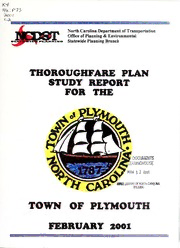
Thoroughfare plan study report for the town of Plymouth PDF
Preview Thoroughfare plan study report for the town of Plymouth
"A;p73 HaWAife^rjMcidHkaiaibafc^aBfftiaMia^ North Carolina Department of Transportation Office of Planning & Environmental Statewide Planning Branch THOROUGHFARE PLAN STUDY REPORT FOR THE , DOCIMNTS I J[EAf#IGHGUSE j V' W ;UeR,«RY OF KiOftTH CAROLINA dUEISH TOWN OF PLTM FEBRUARY 200: Digitized by tlie Internet Archive in 2011 with funding from State Library of North Carolina http://www.archive.org/details/thoroughfareplan2001plym Thoroughfare Plan Study Report for the Town of Plymouth Prepared by the: statewide Planning Branch Division of Highways N. C. Department of Transportation In Cooperation with: The Town of Plymouth The Federal Highway Administration U. S. Department of Transportation February, 2001 Acknowledgments Persons responsible for this report: Project Engineer: Terry C. Arellano, P.E. Systems Planning Engineer: Dan L. Thomas, P.E. Urban Group Manager: Michael S. Bruff, P.E. Manager Statewide Planning Branch: Blake Norwood, P.E. Project Technician: Reuben Crummy V ' n" Executive Summary In December 1997, the Town of Plymouth recognized the importance of the process of planning for future transportation needs and requested thoroughfare planning assistance from the Statewide Planning Branch. The resulting Thoroughfare Plan for the Town of Plymouth, as shown in Figure 2, resulted from the implementation of the thoroughfare planning principles described in Chapter VIII of this report. The Thoroughfare Plan study is based upon the traditional four-step modeling process: trip generation, trip distribution, mode choice, and trip assignment. This study involved two repetitions of this process. The first application required the collection of socio-economic data (employment and housing information), traffic count data, and geometric street data in the 1999 base year. Use of this data resulted in the simulation of a computer model representation of the existing Plymouth traffic patterns. The second application involved the projection of the socio-economic data and external station traffic volumes to the 2025 design year. The four-step process was applied to these projected data, thereby forecasting future traffic patterns for the planning area. A comparison of these traffic patterns to the existing roadway capacities identified anticipated roadway deficiencies for which various solutions were tested. This report documents the findings of this study, along with the resulting recommendations for improvements. In addition, this report presents thoroughfare cross-section recommendations, cost estimates and benefit evaluations for the recommended improvements, and plan implementation recommendations. After several informational meetings with the Planning Department, Town Council, and citizens of the planning area, the Town Council adopted the Plymouth Thoroughfare Plan at a public hearing held on October 16, 2000. Initiative for plan implementation rests largely with the policy boards and citizens of the planning area. Highway needs throughout the State exceed the available funding; therefore, local areas should aggressively pursue funding for the projects they desire. It is important to realize that the recommended thoroughfare plan is based upon anticipated growth and development of the planning area reflecting current zonal trends as provided by the Town of Plymouth. Prior to the construction of specific projects, a more detailed study will be required to reconsider development trends and determine specific design requirements. Table of Contents Page I. Introduction 1 II. Thoroughfare Plan for the Town of Plymouth 9 Intent of the Thoroughfare Plan 9 Recommended Thoroughfare Plan 9 Recommended Improvements 10 III. Implementation 11 State and Municipal Adoption of the Thoroughfare Plan 11 Subdivision Regulations 12 Roadway Official Corridor Map 12 Zoning Ordinances 12 Urban and Community Revitalization 13 Capital Improvements Program 13 Development Reviews 13 Other Funding Sources 14 IV. Travel Deficiency Analysis of Existing System 15 Traffic Collision Analysis 15 Roadway Capacity Deficiencies 16 Bridge Conditions 17 V. Population, Land Use, and Economy 27 Population 27 Land Use 27 Economic Trends 28 Vehicle Registration 29 VI. Environmental Considerations 33 Wetlands 33 Threatened and Endangered Species 33 Historic Sites 34 Archaeological Impacts 34 Housing and Neighborhoods 34 Educational Facilities 35 VII. Traffic Model Development 39 The Planning Area 39 The Base Year Network 39 Trip Generation 40 Trip Distribution 41 Mode Split 43 Trip Assignment 43 Calibration and Model Validation 43 Data Projections 44 VIII. Thoroughfare Planning Principles 51 Objectives 51 Operational Efficiency 51 System Efficiency 54 Applications of Thoroughfare Planning Principles 55 Appendix A: Planning Area Housing and Employment Appendix B: Local Govemment & Public Participation Appendix C: Recommended Subdivision Ordinances Appendix D: Typical Thoroughfare Cross-Sections Appendix E: Thoroughfare Plan Street Tabulations and Recommendations Appendix F: Definitions of Environmental Status Codes Appendix G: Resources & Contacts List of Figures Figure Page 1 Geographic Location Map 3 2 2000 Thoroughfare Plan 5 3 1971 Thoroughfare Plan 7 4 Bridge Deficiencies & Intersections of Concern Location Map 19 5 1996 Base Year Travel & Capacity Deficiencies 21 6 2025 Design Year Travel & Capacity Deficiencies 23 7 Levels of Service 25 8 Dwelling Unit Occupancy 31 9 Planning Area Wetlands 37 10 Planning Area Zone Map 47 11 Planning Area TRANPLAN Network 49 12 Idealized Thoroughfare Plan 57 13 Typical Cross Sections D-3 List of Tables Table Page 1 Intersections of Concern within the Planning Area 15 2 Structurally Deficient & Functionally Obsolete Bndges 18 3 Employment for the Plymouth Planning Area 28 4 Persons per Vehicle for Washington County 29 5 Threatened or Endangered Species within the Planning Area 34 6 Travel Model Input Variables 41 7 Friction Factors 42 8 Model Validation 43 9 Cordon Station Travel 45 10 1999 Socio-Economic Data A-1 11 2025 Socio-Economic Data A-2 12 Design Speeds C-4 13 Maximum Vertical Grade C-5 14 Sight Distance C-6 15 Superelevation Table C-6
